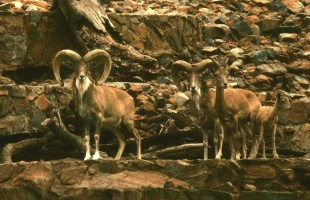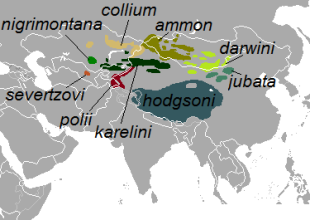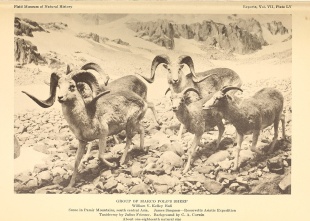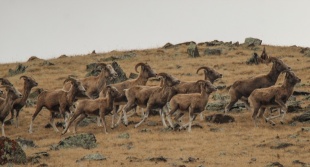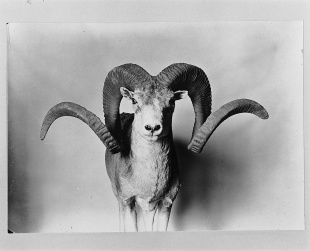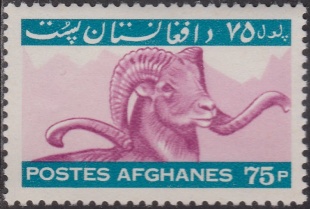ARGALI
Argali (Ovis ammon) are the world’s largest sheep. Also known as mountain sheep, they are native to the highlands and mountains of Central Asia, the Himalayas, Tibet, and the Altai region. They weigh between 43 and 356 kilograms (95 to 729 pounds) and have a shoulder height of 85 to 135 centimeters (three to four feet). North American bighorn sheep may approach comparable weights but are normally considerably to be slightly smaller than by the argali. Argali have large corkscrew-shaped horns with rounded combat edges similar to those of North American bighorn sheep. Both males and female argali have spiraling horns. The horns of males can be up to 1.9 meters (six feet) in length when measured along the coil. Those of females are smaller.
Argali look like American long-horn sheep. Both rre known for the crashing, head-butting battles of males in the mating season. Argali live in open, grassy areas and prefer places with rocky outcrops, foothills, plateaus, valleys, gentle slopes and rolling steppes.. There are believed to be 10,000 to 50,000 of them. The lifespan of Argali sheep averages 10 to 13 years, with the oldest being about 20 years old. Predators and extreme climatic conditions kill older sheep, so maximum lifespan is seldom achieved. Males can generally live longer than females. [Source: John Tonda, Animal Diversity Web (ADW) /=]
Currently nine subspecies of argali are recognized: 1) Altai argali, (Argali ammon); 2)Karaganda argali, (Argali collium); 3) Gobi argali, (Argali darwini); 4) Tibetan argali, (Argali hodgsoni); 5) North China argali, (Argali jubata); 6) Tian Shan argali, (Argali karelini); 7) Kara Tau argali, (Argali nigrimontana); 8) Marco Polo argali, (Argali polii); and 9) Severtzov argali, (Argali severtzovi). Subspecies are distinguished by seasonal age related fur differences, body size and geographic location. /=\
Argali Habitat and Where They Are Found
Argali sheep are found in temperate areas in the mountains of Central Asia at elevations of 1000 to 6000 meters (3281 to 19685 feet) at an average elevation of 3000 meters (9843 feet). They have a wide range with the nine localized subspecies described above and below recognized. The range of the argali sheep stretches from the Irtysh River and Altrai Mountains in Siberia, Kazakhstan and Mongolia southwards to the Himalayas in Tibet and extends from central Kazakhstan and Oxus river near Afghanistanin the west to the Mongolian plateau and Shaanxi Province in China in the east. [Source: John Tonda, Animal Diversity Web (ADW) /=]
Argali sheep usually occupy the same areas for the duration of their lives. Their large size of males allows them live out on the open without having to worry to much about predators. As a result they choose prime vegetative habits that are more exposed than are those chosen by smaller females and young rams. During summertime as food becomes available, higher elevations are chosen by all animals.
The landscape of central Asia is vast and mostly open. Mountains have been worn down by erosion and huge sloping hills remain, allowing a great range of visibility for the animals which live there. Vegetation is dominated by grasses, with very few trees present on the landscape. In protected areas, argali tend to prefer gently sloping areas with soft broken terrain, although ewes with lambs often seek out more precipitous areas, with canyons and jagged rocks. In areas where they are extensively hunted (such as Kazakhstan), they are more likely to be found in forested areas. In parts of China and Russia where they compete for resources with numerous domestic stock, Argalis more regularly take up residence in precipitous, jagged areas. When in the mountains, avod areas that have heavy snow cover in the winter, following winds that blow snow off the earth. Rams are generally found at higher elevations more regularly than females and stay at higher elevations longer during the wintertime.[Source: Wikipedia; Alexander K. Fedosenko and David A. Blank Argali. Mammalian Species, No. 773, (July 15, 2005),pp. 1-15]
Argali Subspecies
The nine argali subspecies and where they live:
1) Altai argali (O. a. ammon) occurs in the Altai Mountains of western Mongolia; its range extends marginally north into the Gorno-Altai and Tuva republics of Siberian Russia, extreme northeast Kazakhstan, and southwest into Xinjiang, China.
2) Karaganda argali (O. a. collium) inhabits the Karaganda Region of east and central Kazakhstan.
3) Kara Tau argali (O. a. nigrimontana) inhabits the Karatau Mountains of Kazakhstan.
4) Marco Polo sheep (O. a. polii) inhabits Afghanistan, China, Kyrgyzstan, Pakistan and Tajikistan.
5) Severtzov argali (O. a. severtzovi) lives in Kyrgyzstan, Tajikistan and Uzbekistan.
6) Gobi argali (O. a. darwini) lives in northern China and southern Mongolia.
7) Tibetan argali (O. a. hodgsoni) occurs across India, Nepal, Bhutan and China.
8) North China argali (O. a. jubata) is restricted to northeast China.
9) Tian Shan argali (O. a. karelini) inhabits the Tian Shan of eastern Kyrgyzstan.
Some sources classify mouflon as Argali musimon. However, DNA testing has not supported this. Several subspecies of argali have been genetically tested for mtDNA and one study found that the subspecies Altai argali (Argali ammon), Gobi argali (Argali darwini) and the urial subspecies, O. vignei bochariensis grouped closely while the subspecies Karaganda argali ( Argali collium) and Kara Tan argali (Argali nigrimontana) grouped with the urial subspecies O. vignei arkal.
Marco Polo Sheep
Marco Polo sheep (Ovis ammon polii) are subspecies of argali, named after Marco Polo. They are found mainly in the Pamir Mountains region adjacent to the borders of Afghanistan, Pakistan, Kyrgyzstan, Tajikistan and China. They are generally found at elevations from 3,700 to 4,800 meters (12,100 to 15,700 fet). They are found in the greatest numbers in Pakistan in the northwestern part of the Hunza district along the Chinese border, where they inhabit the Kilik Mintaka border and the northwestern area of Khunjerab National Park. Marco Polo sheep also inhabit the Wakhan Corridor, along the Afghanistan border. They share much of their habitat with animals such as the Siberian Ibex. [Source: Wikipedia]
Marco Polo sheep are also known as Marco Polo's argali and Pamir argali. They are named after the 13th century explorer Marco Polo because he described them in his book The Travels of Marco Polo after witnessing them in the Pamirs before his arrival in China. The Marco Polo subspecies was first described scientifically by zoologist Edward Blyth in 1841. Marco Polo sheep are distinguishable mostly by their large size and spiraling horns, which resemble those of North American big horn sheep. Their conservation status is "near threatened" and efforts have been made to protect their numbers and keep them from commercial hunting. It has also been suggested that crossing them with domestic sheep could have agricultural benefits.
Marco Polo sheep are particularly known for their long, spiraling horns which may reach an uncoiled length of 1.4 meters (3.75 feet). They have the longest horns of all sheep, with the longest individual horn ever recorded — measuring 1.9 meter (6.2 feet) and weighing 60 pounds (27 kilograms). Marco Polo sheep horns follow a coil pattern, with the tips pointed directly away horizontally from the head; in spite of this, the tips are rarely broken. The horns have long been a popular attraction for trophy hunters. They begin growing 15 to 20 days after the sheep are born. Their growth in length is most pronounced during the first year. Thickness growth is most noticeable during the first two years.
Mature rams on average weigh 126 kilograms (280 pounds). The stand approximately 1.13 meters (3.6 feet) at the shoulder while ewes reach one meter (3.3 feet). Marco Polo sheep rut in December. Gestation lasts about 160 days, with single births being the norm and twins uncommon. A captive ewe once gave birth to five lambs at once, then triplets two years later. Marco Polo sheep have an average life span of 13 years. The horns develop rings each year by which the age of male animals may be determined.
Argali Characteristics
Argali weigh between 43 and 356 kilograms (95 to 729 pounds) and have a shoulder height of 85 to 135 centimeters (three to four feet). They measure 1.36 to two meters (4.5 to 6.6 feet) in lenth from the tip of their head to the base of the tail. Argali have the shortest tail of any wild goat-antelope or sheep, relatively to size, with reported tail lengths of 9.5 to 17 centimeters (3.7 to 6.7 inches) the norm. The Pamir argali — also called Marco Polo sheep as they were described by Marco Polo in the 13th century — is the largest subspecies. On average, they regularly measuring more than 180 centimeters (5.9 feet) long without the tail, and are less sexually dimorphic in body mass than most other subspecies. [Source: John Tonda, Animal Diversity Web (ADW); Wikipedia; Alexander K. Fedosenko and David A. Blank Ovis ammon. Mammalian Species, No. 773, (July 15, 2005)]
Sexual Dimorphism (differences between males and females) is present: Males are much larger than females — sometimes twice as large. Sexes are colored or patterned differently. Ornamentation is different. Females (ewes) can weigh from 43.2 to 100 kilograms (95 to 220 pounds) while males (rams) typically weigh from 97 to 182 kilograms (210 to 400 pounds), with larger ones weighing 216 kilograms (480 pounds). Males have two large corkscrew horns, some measuring 190 centimeters (6.2 feet) in total length and weighing up to 23 kilograms (51 pounds). Males use their horns for competing with one another. Females also have horns, but they are much smaller, usually measuring less than 50 centimeters (20 inches) in total length. ++
As for coloration, argali have a dark band running laterally along the belly, separating the dark brown upper half from the paleer area below. Argali sheep have a distinct, light rump patch and pale face. Males generally have a light colored neck. The coat is shed twice yearly, with the summer coat being darker and the winter coat having a longer hair length. Coloration also varies between each animal, from a light yellow, a reddish-brown to a dark grey-brown, and is different among the different subspecies. . Argali from the Himalayas are usually relatively dark whereas those from the Altai region are often relatively pale. In summertime, the coat is often lightly spotted with a salt-and-pepper colouration. The back is darker than the sides, which gradually lighten in color. The face, tail and the buttocks are yellowish-white. Males have a whitish neck ruff and a dorsal crest and are usually slightly darker in color than the female.
Argali Food and Eating Behavior
Argali sheep are herbivores (primarily eat plants or plants parts) and are also recognized as folivores (eat leaves) and granivore (eats seeds and grain). They mainly eat grasses but also eat leaves seeds, grains, and nuts. [Source: John Tonda, Animal Diversity Web (ADW) /=]
Argali are grazers eating grass off the ground rather than grazers who eat leaves and other plant matter from bushes and trees although they sometimes eat those too. The landscape inhabited by argali is relatively free of trees, but plentiful in grasses, herbs, and sedges — food easily and efficiently digested by these goats. Females and young rams feed in higher altitude terrain with diminished food quality. These feeding locations provide easy escape protection from predators. Adult males feed in lower terrain with higher food quality and use fast, sustained running to evade predators. /=\
Adult argalis eat 16-19 kilograms (35-42 pounds) of food a day. The vegetation preferred by the species varies based on elevation and area. In higher elevations, they predominantly eat cereals, sedges and forbs (herbaceous flowering plants). At mid-elevation habitats, they more regularly feed on bushes and mesophyte grasses. In the lowest ranges and the spurs of deserts, Argalis cereals and sedges again predominant but often of different species than the high elevation ones. In north-central Kazakhstan, sprouts, leaves, flowers and fruits are significant to the diet all year, whereas they appear to be a rare dietary supplement over the rest of the range. Water is needed by argalis, which is rarely a problem for specimens living in high elevation, where melting snow and small waterways are regularly encountered. In drier climes, argali may travel several kilometers in search of water. When available, argali readily consume saline soil. [Source: Wikipedia; Alexander K. Fedosenko and David A. Blank Argali. Mammalian Species, No. 773, (July 15, 2005), pp. 1-15]
Bovids
Bharal are bovids. Bovids (Bovidae) are the largest of 10 extant families within Artiodactyla, consisting of more than 140 extant and 300 extinct species. According to Animal Diversity Web: Designation of subfamilies within Bovidae has been controversial and many experts disagree about whether Bovidae is monophyletic (group of organisms that evolved from a single common ancestor) or not. [Source: Whitney Gomez; Tamatha A. Patterson; Jonathon Swinton; John Berini, Animal Diversity Web (ADW) /=]
Wild bovids can be found throughout Africa, much of Europe, Asia, and North America and characteristically inhabit grasslands. Their dentition, unguligrade limb morphology, and gastrointestinal specialization likely evolved as a result of their grazing lifestyle. All bovids have four-chambered, ruminating stomachs and at least one pair of horns, which are generally present on both sexes.
Bovid lifespans are highly variable. Some domesticated species have an average lifespan of 10 years with males living up to 28 years and females living up to 22 years. For example, domesticated goats can live up to 17 years but have an average lifespan of 12 years. Most wild bovids live between 10 and 15 years, with larger species tending to live longer. For instance, American bison can live for up to 25 years and gaur up to 30 years. In polygynous species, males often have a shorter lifespan than females. This is likely due to male-male competition and the solitary nature of sexually-dimorphic males resulting in increased vulnerability to predation. /=\
See Separate Article: BOVIDS: CHARACTERISTICS, BEHAVIOR, SUBFAMILIES factsanddetails.com
Ruminants
Cattle, sheep, goats, yaks, buffalo, deer, antelopes, giraffes, and their relatives are ruminants — cud-chewing mammals that have a distinctive digestive system designed to obtain nutrients from large amounts of nutrient-poor grass. Ruminants evolved about 20 million years ago in North America and migrated from there to Europe and Asia and to a lesser extent South America, where they never became widespread.
As ruminants evolved they rose up on their toes and developed long legs. Their side toes shrunk while their central toes strengthened and the nails developed into hooves, which are extremely durable and excellent shock absorbers.
Ruminants helped grasslands remain as grasslands and thus kept themselves adequately suppled with food. Grasses can withstand the heavy trampling of ruminants while young tree seedlings can not. The changing rain conditions of many grasslands has meant that the grass sprouts seasonally in different places and animals often make long journeys to find pastures. The ruminants hooves and large size allows them to make the journeys.
Describing a descendant of the first ruminates, David Attenborough wrote: deer move through the forest browsing in an unhurried confident way. In contrast the chevrotain feed quickly, collecting fallen fruit and leaves from low bushes and digest them immediately. They then retire to a secluded hiding place and then use a technique that, it seems, they were the first to pioneer. They ruminate. Clumps of their hastly gathered meals are retrieved from a front compartment in their stomach where they had been stored and brought back up the throat to be given a second more intensive chewing with the back teeth. With that done, the chevrotain swallows the lump again. This time it continues through the first chamber of the stomach and into a second where it is fermented into a broth. It is a technique that today is used by many species of grazing mammals.
See Ruminants Under MAMMALS: HAIR, HIBERNATION AND RUMINANTS factsanddetails.com
Argali Behavior and Communication
Argali are diurnal (active during the daytime), motile (move around as opposed to being stationary), nomadic (move from place to place, generally within a well-defined range), sedentary (remain in the same area), social (associates with others of its species; forms social groups), and have dominance hierarchies (ranking systems or pecking orders among members of a long-term social group, where dominance status affects access to resources or mates). The home range of these animals has not been reported. [Source: John Tonda, Animal Diversity Web (ADW) /=]
Argalis live in herds typically numbering between 2 and 150 animals, segregated by sex, except during breeding season. Most populations show large numbers of adult females, comprising more than half of a local population, against around 20 percent being comprised by adult males and a further 20 percent by young argali. Some rams are solitary but most are seen in small herds numbering between 3 and 30 individuals. Females and their young live in larger groups, regularly up to 92 individuals and exceptionally to 200 animals. [Source: Wikipedia; Alexander K. Fedosenko and David A. Blank Ovis ammon. Mammalian Species, No. 773, (July 15, 2005) ++]
Migrating herds, especially males, have been reported. Most migration appear to be related to seasonally decreased food sources, though an overabundance of biting insects (especially gadflies), severe drout or fires, poaching by humans and large numbers of domestic livestock may also trigger movements. With their long legs, herds can travel quickly from place to place. Argalis tend to live at higher elevations during the summer. ++
Argali are sheep. Sheep are very calm and non aggressive towards other sheep, and are very social animals. Members of a herd follow one another, and an individual sheep will often seek contact with other sheep. /A strategy of safety in numbers is common of all the worlds’ sheep. It is thought that a sheep may help to protect itself from predation by being close to another sheep, who might fall victim to an attack instead. When spooked, a solitary sheep may remain motionless until the threat disappears. This is very different from the behavior of these sheep in a herd — when alarm will cause them to run and jump away. /=\
Argali communicate and sense with vision, touch, sound and chemicals usually detected by smelling. They also employ pheromones (chemicals released into air or water that are detected by and responded to by other animals of the same species) and scent marks produced by special glands and placed so others can smell and taste them. Argali sometimes communicate by hissing through the nostrils or grunting from their throat. Communication is important between mother and young and utilizes visual, oral and scent confirmations. Communication through scent glands is not well understood but thought to be important in mating. Males smell females that are fertile and ready to mate. Distinctive fur can be a long-distance visual signal to other sheep of where other herds are. This information can be used by the sheep when deciding to avoid or join other groups. /=\
Argali Mating and Reproduction
Argali are polygynandrous (promiscuous), with both males and females having multiple partners. They engage in seasonal breeding — breeding once per year in the autumn and early winter. Females are fertile about every three weeks in the fall until they are impregnated. The number of offspring ranges from one to two, with the average number of offspring being one. The gestation period is around 5.17 months. Ewe can reproduce when they are one years old, but the majority of females wait for their second year. Females can produce young successfully for up to eight years. [Source: John Tonda, Animal Diversity Web (ADW); Wikipedia; Alexander K. Fedosenko and David A. Blank Ovis ammon. Mammalian Species, No. 773, (July 15, 2005) ++]
Argali males often mate with several females. Numerous matings can occur in a season between many partners. Dominant males may form harems and mate with numerous females within the harem during the rut. Females may mate with numerous males if the opportunity arises. Such opportunities may arise when the dominance among males changes or when a female leaves a herd to join another group.
Argali reach breeding maturity at two to three years of age. Rutting often begins around October and ends in mid-January, generally lasting longer in lower elevations. In rutting herds, both rams and ewes attack others of their own sex, exerting dominance by ramming each other with their horns. Although such groups engage in lamb-like play, the combat of a pair of mature males is a serious business. Huge rams weighing 180 kilograms run head first into each other while in rut. They smash their horns together in intense combat designed to determine dominance relationshipes between males. Dominant males then mate with mature females in estrous. /=\
The rams slam into each other, with their forelegs up in the air, exerting enough force to be heard up to 800 meters (2,600 feet) away. Often the older males (over six years of age), which are also often the largest, end up the dominant ones and younger males are chased off once the ewes are in estrus. Once dominance is established, the top rams begin approaching ewes and smell their urine to determine their receptiveness. Ram then repeatedly approach ewes and forceably mount them. Mating starts around two to three weeks after the rutting begins. Rams may remain in the company of ewes for up to one to two months after the rutting period is over. ++
Argali Offspring and Parenting
Births typically occur in late March or April, with some females producing no offsping. The age at which young are weaned ranges from four to five months. The average time to independence is five months. Males do not participate in care of the young. Pre-weaning provisioning is provided by females. There is an extended period of juvenile learning. On average females reach sexual or reproductive maturity at one years but don’t start reproducing until they are two. .On average males reach sexual or reproductive maturity at five years. The different ages is at least partly explained by the fact that males grow much larger than the females before they can breed. [Source: John Tonda, Animal Diversity Web (ADW) /=]
Most argali subspecies give birth to a single lamb, though in some twins are not uncommon and as many as five have been reported. At birth, the lambs weigh 2.7 to 4.6 kilograms (6 to 10 pounds). Females separate from the herd to give birth and remain separated for a few days. During this time, the lamb lays motionless while the mother grazes. Lambs are precocial at birth, and can stand. The newborn lamb and mother ewe stay around where the birth occurs overnight and, on the next day, both usually walk together.
Mothers care for young for about four months before weaning. Young sheep nurse before weaning, receiving milk high in fat protein and antibodies to help add body mass and sustain health and vitality. During nursing, young lambs also receive bacteria needed for ruminant digestion. During this period young lambs grow rapidly, gain weight and increase in size — which are important for survival. Muscle tone and coordination are further developed during nursing. Weight gain is often quite fast and the lambs may weigh 10 times their birth weight by their first birthday.
Lambs play a great deal, learning behaviors necessary for survival, such as mating rituals, how to escape from predators, and how to be agile on the steep terrain found in their normal habitat Lambs often play in groups, jumping up and down together, sometimes being joined by their mothers. Until about age two social skills are learned. A one year old could mate physiologically but does not have necessary social skills. Social skills are important since sheep are very social animals and spend their entire lives in groups.
After a lamb is a few months old, the relationship between mother and lamb ends. Lambs usually form their own social groups. Females often attain their maximum mass by two years of age, but males continue to grow larger and heavier in their third and fourth years. Milking teeth develop around three months of age, with a full set of teeth developing by around 6 months. By the time their teeth develop, lambs are capable grazers when the ewes stop nursing them.
Argali and Predators
Argali are prey upon by gray wolves, leopards, snow leopards and humans. The main predator on them is gray wolves, which often exploit harsh winter conditions (such as deep snow) in order to capture them, though they can and do take individuals of any age or condition year around. Eurasian lynx and wolverines may seldomly kill adult male argali due to their size but may taje lambs and winter-weakened ewes. Red foxes and domestic dogs (largely those kept by sheep-herders) take lambs. [Source: Wikipedia; Alexander K. Fedosenko and David A. Blank Ovis ammon. Mammalian Species, No. 773, (July 15, 2005) ++]
Cinereous vultures, lammergeiers and golden eagles have been observed circling herds of ewes with lambs in a possibly predacious manner and remains of argali lambs have been observed at golden eagle nests. Smaller predators, such as raptorial birds and smaller mammalian carnivores, are attacked by mother ewes but, in the presence of larger predators, the ewes quickly run away with the lambs following them.
Argali — especially females and young — try to stay in areas inaccessible to predators, such as high on hills or on steep embankments with good viewpoints. Argali sheep seldom use their horns in defence against predators. Instead, they use avoidance and rapid flight from predators as their main strategies to avoid being eaten. Also, to avoid predation all animals in a herd move together and stay with group. If an Argali sheep is alone, it will sometimes remain motionless in the hope of being overlooked by a predator. Due to their large size, male argali are poor jumpers and do not usually jump as an escape, but smaller females and young animals sometimes do. Powerful long legs help these sheep run over all types of terrain. /=\
Argali, Humans, Hunting and Conservation
On the International Union for Conservation of Nature (IUCN) Red List argail are listed as Near Threatened. On the US Federal List they are classified as Endangered. In CITES (Convention on International Trade in Endangered Species of Wild) they are in Appendix I. Populations of all subspecies are on the decline. They are threatened by hunters and poachers and loss of habitat caused by grazing and overgrazing livestock. Their fur and hides have been made into clothing and leather goods. Trophy hunting, which has been going on since the 19th century, has removed argali from much of its former range. [Source: John Tonda, Animal Diversity Web (ADW) /=]
Argalis are considered near threatened throughout their entire range. As the world's largest sheep, they are sought after by trophy hunters — willing to spend big money — for their spiraling horns and are also hunted for meat and body parts that are used in traditional medicine. This is one of the main reasons poaching continues to be a major (and difficult-to-manage) problem. But on the other side of the coin revenue raised from the hunting expeditions — and from ecotourism too — provides revenues for often poor local people and for conservation. Argali can negatively affect humans by competing with livestock for grazing lands. But mostly Argali sheep are in remote areas not used by domestic livestock. It is more likely that the domestic animals raised by humans have negatively impacted Argali sheep by pushing them into more remote, lower quality habitats. /=\
Argalis have been expirated from northeastern China, southern Siberia and parts of Mongolia. Populations of predators such as gray wolves and snow leopards appear to have been negatively effected by the scarcity of argalis as they are a major source of food for these animals. [Source: Wikipedia; Alexander K. Fedosenko and David A. Blank Ovis ammon. Mammalian Species, No. 773, (July 15, 2005) ++]
Some argalis live in the same areas as Siberian ibex, but the paths of the two species don’t cross so much as they have different habitat and pasture preferences, reducing possible competition. In Tibet, the must compete with other grazing species for pasture, including Tibetan antelope, bharal, Thorold's deer and wild yaks. Competition is most severe with livestock, especially domesticed yak and sheep, from which Argali are related and sometimes get diseases and parasites from. ++
Wildlife researchers have concluded that the greatest threat Marco Polo sheep is commercial hunting. Hunting the Marco Polo sheep first took off in the 1950s Mohammed Zahir Shah, king of Afghanistan, hunted and killed a ram and afterwards declared that the valley in which he hunted be a protected habitat for the sheep as a hunting grounds for Afghan royalty. It was not until 1968 that an American tourist was allowed to hunt in the reserve. In 2008, it was estimated that American hunters paid an average of $20,000 to $25,000 for an expedition to hunt a Marco Polo sheep. In 1976, in Khunjerab, the Marco Polo sheep's population was estimated to be 300. This number declined to 160 between 1978 and 1981, and declined again to only 45 in 1991. George Schaller of the Wildlife Conservation Society estimated the worldwide population in 2003 as around 10,000, half what Ronald Petocz estimated in his 1973 tour. Their population density has been recorded as fewer than two animals per one square kilometre (0.39 per square mile). Marco Polo sheep were included on the first list of protected species issued by the Afghanistan National Environmental Protection Agency, in June 2009.
Image Sources: Wikimedia Commons
Text Sources: Animal Diversity Web animaldiversity.org ; National Geographic, Live Science, Natural History magazine, CNTO (China National Tourism Administration) David Attenborough books, New York Times, Washington Post, Los Angeles Times, Smithsonian magazine, Discover magazine, The New Yorker, Time, BBC, CNN, Reuters, Associated Press, AFP, Lonely Planet Guides, Wikipedia, The Guardian, Top Secret Animal Attack Files website and various books and other publications.
Last updated April 2025

